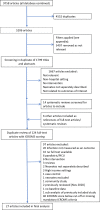The Impact of Interventions to Prevent Neonatal Healthcare-associated Infections in Low- and Middle-income Countries: A Systematic Review
- PMID: 35134037
- PMCID: PMC8815829
- DOI: 10.1097/INF.0000000000003320
The Impact of Interventions to Prevent Neonatal Healthcare-associated Infections in Low- and Middle-income Countries: A Systematic Review
Abstract
Background: Clinically suspected and laboratory-confirmed bloodstream infections are frequent causes of morbidity and mortality during neonatal care. The most effective infection prevention and control interventions for neonates in low- and middle-income countries (LMIC) are unknown.
Aim: To identify effective interventions in the prevention of hospital-acquired bloodstream infections in LMIC neonatal units.
Methods: Medline, PUBMED, the Cochrane Database of Systematic Reviews, EMBASE and PsychInfo (January 2003 to October 2020) were searched to identify studies reporting single or bundled interventions for prevention of bloodstream infections in LMIC neonatal units.
Results: Our initial search identified 5206 articles; following application of filters, 27 publications met the inclusion and Integrated Quality Criteria for the Review of Multiple Study Designs assessment criteria and were summarized in the final analysis. No studies were carried out in low-income countries, only 1 in Sub-Saharan Africa and just 2 in multiple countries. Of the 18 single-intervention studies, most targeted skin (n = 4) and gastrointestinal mucosal integrity (n = 5). Whereas emollient therapy and lactoferrin achieved significant reductions in proven neonatal infection, glutamine and mixed probiotics showed no benefit. Chlorhexidine gluconate for cord care and kangaroo mother care reduced infection in individual single-center studies. Of the 9 studies evaluating bundles, most focused on prevention of device-associated infections and achieved significant reductions in catheter- and ventilator-associated infections.
Conclusions: There is a limited evidence base for the effectiveness of infection prevention and control interventions in LMIC neonatal units; bundled interventions targeting device-associated infections were most effective. More multisite studies with robust study designs are needed to inform infection prevention and control intervention strategies in low-resource neonatal units.
Copyright © 2022 The Author(s). Published by Wolters Kluwer Health, Inc.
Figures
References
-
- Fitchett EJA, Seale AC, Vergnano S, et al. ; SPRING (Strengthening Publications Reporting Infection in Newborns Globally) Group. Strengthening the Reporting of Observational Studies in Epidemiology for Newborn Infection (STROBE-NI): an extension of the STROBE statement for neonatal infection research. Lancet Infect Dis. 2016;16:e202–e213. - PubMed
-
- Zaidi AK, Huskins WC, Thaver D, et al. Hospital-acquired neonatal infections in developing countries. Lancet. 2005;365:1175–1188. - PubMed
-
- Okomo U, Akpalu ENK, Le Doare K, et al. Aetiology of invasive bacterial infection and antimicrobial resistance in neonates in sub-Saharan Africa: a systematic review and meta-analysis in line with the STROBE-NI reporting guidelines. Lancet Infect Dis. 2019;19:1219–1234. - PubMed
-
- Gould DJ, Creedon S, Jeanes A, et al. Impact of observing hand hygiene in practice and research: a methodological reconsideration. J Hosp Infect. 2017;95:169–174. - PubMed
Publication types
MeSH terms
Grants and funding
LinkOut - more resources
Full Text Sources
Medical
Miscellaneous


